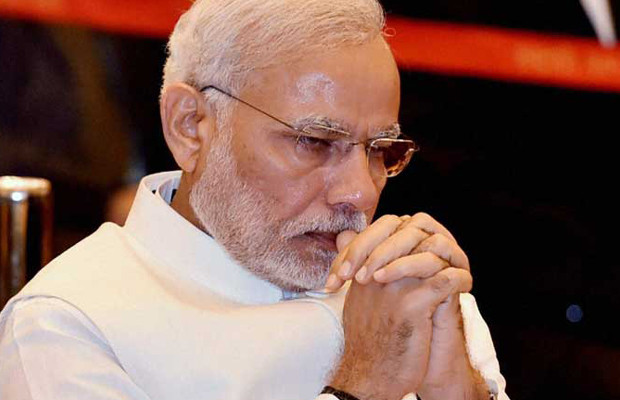STRONG HEADWIND FOR MODI TO CROSS

To form a Grand Alliance of regional parties and lead it from the front looks easy for the Congress.
The results of the municipal council and Nagar panchayat polls in Maharashtra are a clear indication that the direction of wind has taken a U-turn for Bhartiya Janta Party (BJP) after Bihar Assembly election and Prime Minister Narendra Modi and party president Amit Shah are finding themselves helpless to adjust the sails to reach to their 2019 destination. BJP faced a stunning blow in Gujarat in early December and 2016 has begun for the right wing party with finishing fourth in Maharashtra. Congress has gained strongly in the home state of Modi and Shah after remaining almost totally absent from all tiers of the power structure by losing every election in the last 12 years and now the final tally in Maharashtra showed Congress on the top.
In spite of inherent contradictions, a grand anti-Modi alliance now does not seem entirely impossible and if the majority of the bigger opposition parties rally against BJP in 2019, it could lose as 69 percent electorate voted against it even at the time when its popularity was at the highest level in 2014. BJP, not the Congress, is now the principal party in the country. Not only does it have 281 MPs in Lok Sabha, but also Chief Ministers in eight states—Gujarat, Maharashtra, Goa, Madhya Pradesh, Chhattisgarh, Rajasthan, Jharkhand and Haryana. In five states/Union Territories (UTs), its allies occupy the CM’s chair. With Jammu and Kashmir, Andhra Pradesh, Punjab, Nagaland and Puducherry, BJP/NDA-ruled states are at 13. This is 40 percent of the total number of states/UTs in India. Contrast to this the Congress rules/shares power in ten states, half of which are in the Northeast. They are very small and do not play a dominant role in national politics. Even then, if many parties are keen to jump onto the anti-BJP bandwagon keeping in mind 2019, it speaks of the fact how fast Modi wave has diminished.
44 percent of total members of both the houses of Parliament and 22 percent of total members in all the state Assemblies are in BJP’s kitty. Congress has only 12 percent members in Lok Sabha and Rajya Sabha but it controls 24 percent seats in assemblies across the country. Other political parties have 44 percent of parliamentary share and 54 percent of Assemblies’ with them. As the grand old party is becoming more and more accommodative owing to a real threat, the scope of paradigm shift in political alliances has tremendously widened.
From being principally Hindi heartland party, BJP is trying to spread its wings to the states like Odisha, Tamil Nadu, West Bengal, Kerala, and Assam. BJP feels that its Hindutva agenda can attract at least half of the Hindu votes which are enough to win any election. But the colour of country’s political map is taking a fast change after the elections in Delhi and Bihar. Both the states have proved that a united opposition is an assured guarantee of BJP’s defeat. Arithmetic advantage of this formula in 2019 will be too much for BJP to handle. An umbrella alliance of anti-BJP forces will be taking a proper shape by next year.
464 parties participated in 2014 election along with independents. Only 17 parties recorded a vote share greater than one per cent, accounting for 86.9 percent of total votes polled. Excluding BJP, this leaves 16 parties to come to some sort of common understanding. TDP and Shiv Sena are currently with NDA but their relationship with BJP is in turmoil. The fact is that except for the BJD, TDP and Shiv Sena, all parties have had some sort of relationship with the Congress earlier.
Therefore, to form a grand alliance of regional parties and lead it from the front looks easy for the Congress. It is also a fact that it is not as simple as it appears because of the acrimonious history of some of the parties. SP and BSP can’t sail on the same boat. Similar is the case with AIADMK and DMK, TRS and TDP, Shiv Sena and NCP.
Sonia Gandhi and Rahul Gandhi will have to deal with some of their regional satraps also who will not want Congress to lead an alliance. In that case, the ball will go in regional parties’ court for leading the alliance. But when it will come to projecting the Prime Ministerial candidate how will Nitish Kumar agree on Mamta Banerjee? How Mamta and Mulayam Singh Yadav will agree on Naveen Patnaik? How Naveen will agree for Chandra Babu Naidu? And so on. The leadership issue will the biggest tangle and that might ultimately roll the ball in Congress’ hands as it is the only party with pan-India presence.
Watching Narendra Modi govern India, a potent grand anti-BJP/anti-Modi alliance in 2019 is bound to take shape. There is no honest drive in his regime to undo India’s crony capitalism. Modi is heavily relying on populist slogans and his “together with all, development for all” type rhetorical have already lost steam in public perception. Manipulative president of BJP, Amit Shah, has also lost his skills. Just one and a half year back, there were people who were not Modi’s most natural supporters, but who believed that an end to Congress rule was necessary. They all are highly disappointed with the governance Modi government has provided during this period. They believed in Modi and company election slogans and now feel swindled. They find that after campaigning the Amit Shah Way, Modi is now governing the Amit Shah Way.
Nobody could have imagined that Modi’s connect with people will be converted in such disconnect within one and a half years of his governance. Rural Maharashtra and Gujarat’s writing on the wall tells us of the times BJP is going to face on its route to 2019. If the ambitions of becoming Prime Minister will not hamper the success of mega-alliance, BJP is already preparing for its way out.









You must be logged in to post a comment Login